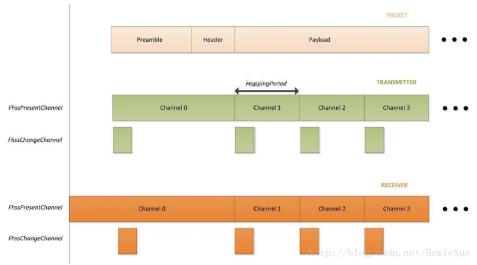The Principle of Frequency Hopping Spread Spectrum Communication (FHSS)
FHSS, frequency hopping spread spectrum technology, under the condition of synchronization and simultaneity, accepts the signals transmitted by narrow-band carriers of a specific type (this specific form has a specific frequency, etc.) at both ends. For a receiver without a specific type, the hopping signal generated by FHSS is only impulse noise to it and will not receive this part of the signal.
Why is FHSS needed? Of course, the transmission data will not be so large only within the specified range. If the transmission time of a single data packet may exceed the maximum channel dwell time allowed by relevant regulations, FHSS technology will be used. To enable the frequency hopping mode in Lora, operate the reg hopping period and frequency hopping period registers to set them to non-zero values. The following explains the knowledge points of this part clearly through the principle.
Principle: The working principle of the FHSS frequency hopping spread spectrum scheme is: that when frequency hopping is required for a part of each Lora data packet, the content needs to be sent through the frequency hopping channel set by MCU management. The frequency to be hopped is required to be sent according to the frequency query table. After the data transmission is completed and the predetermined frequency hopping period ends, the transmitter and the receiver switch to the next channel in the frequency hopping predefined list to continue transmitting and receiving the next part of the data packet. The dwell time in any channel is determined by the frequency hopping period, which is an integer multiple of the symbol length.
The process of transmitting and receiving through frequency hopping starts from channel 0. The preamble and header are transmitted on channel 0 first. Each time a data packet is sent, the reading of the channel counter on the present channel (located in the reg hopping channel) will increase, and an interrupt signal FHSS change channel will be generated to achieve frequency hopping. A new frequency must be set in the frequency hopping period to ensure that the new frequency will be covered in the next frequency hopping. Check process: start FHSS reception on channel 0. After checking the preamble, the receiver will start the above frequency hopping process. At this time, if the CRC of the header is incorrect, the receiver will automatically request channel 0 (packet retransmission mechanism) and restart checking the preamble.
The above article explanation of the principle of frequency hopping spread spectrum communication (FHSS) brought to you by Shenzhen HDV Phoelectron Technology Co., Ltd. Hope this article can help you to increase your knowledge. Besides this article if you’re looking for a good optical fiber communication equipment manufacturer company you may consider about us.
